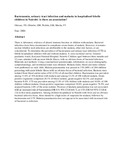Bacteraemia, urinary tract infection and malaria in hospitalised febrile children in Nairobi: is there an association?

View/
Date
2004Author
Okwara, FN
Obimbo, EM
Wafula, EM
Murila, FV
Type
ArticleLanguage
enMetadata
Show full item recordAbstract
There is laboratory evidence of altered immune function in children with malaria. Bacterial infections have been documented to complicate severe forms of malaria. However, it remains unclear whether such infections are attributable to the malaria, other risk factors, or are coincidental. To determine the prevalence of bacteraemia and urinary tract infections (UTI) in febrile hospitalised children with and without malaria. A cross-sectional survey. General paediatric wards, Kenyatta National Hospital, Nairobi. Children aged between three months and 12 years admitted with an acute febrile illness, with no obvious focus of bacterial infection. MATERIALS AND METHODS: Using a standardised questionnaire, information on socio-demography, symptomatology, and nutritional status was obtained. Malaria slides, blood and urine cultures were performed on each child. Malaria parasitaemia was present in 158 (60%) of 264 children presenting with acute febrile illness with no obvious focus of bacterial infection. Bacteria were isolated from blood and/or urine of 62 (23%) of all enrolled children. Bacteraemia was prevalent among 11.4% of 158 children with malaria and among 13.2% of 106 without malaria. Gram-positive organisms comprised 28.1% of blood isolates, gram-negative 62.5%, and atypical bacteria 9.4%. UTI was prevalent among 13.3% of 158 children with malaria and 16.0% of 106 children without malaria. Gram-positive organisms comprised 18.4%, gram-negative 78.9%, and atypical bacteria 2.6% of the urine isolates. Presence of malaria parasitaemia was not associated with an increased risk of bacteraemia (OR 0.9, 95% CI [0.4-0.7], or UTI (OR 0.8 95% CI [0.4-1.6] in this study population. Among children hospitalised in Nairobi with fever and no obvious bacterial infective focus, there should be a high index of suspicion for malaria, followed by bacteraemia and UTI. Malaria parasitaemia does not appear to be associated with increased risk of bacterial co-infection.
URI
http://erepository.uonbi.ac.ke:8080/xmlui/handle/123456789/49865http://www.ncbi.nlm.nih.gov/pubmed/15080516
Citation
FLORENCE, DRMURILA, MASIBO PROFWAFULAEZEKIEL, ELIZABETH DROBIMBO. 2004. Bacteraemia, urinary tract infection and malaria in hospitalised febrile children in Nairobi: is there an association? East Afr Med J . 2004 Jan; 81 ( 1 ): 47-51 . PMID: 15080516 [PubMed - indexed for MEDLINE] Okwara FN, Obimbo EM, Wafula EM, Murila FV. East Afr Med J . 2004 Jan; 81 ( 1 ): 47-51 .. : Kisipan, M.L.Publisher
University of Nairobi
Collections
- Faculty of Health Sciences (FHS) [10377]
